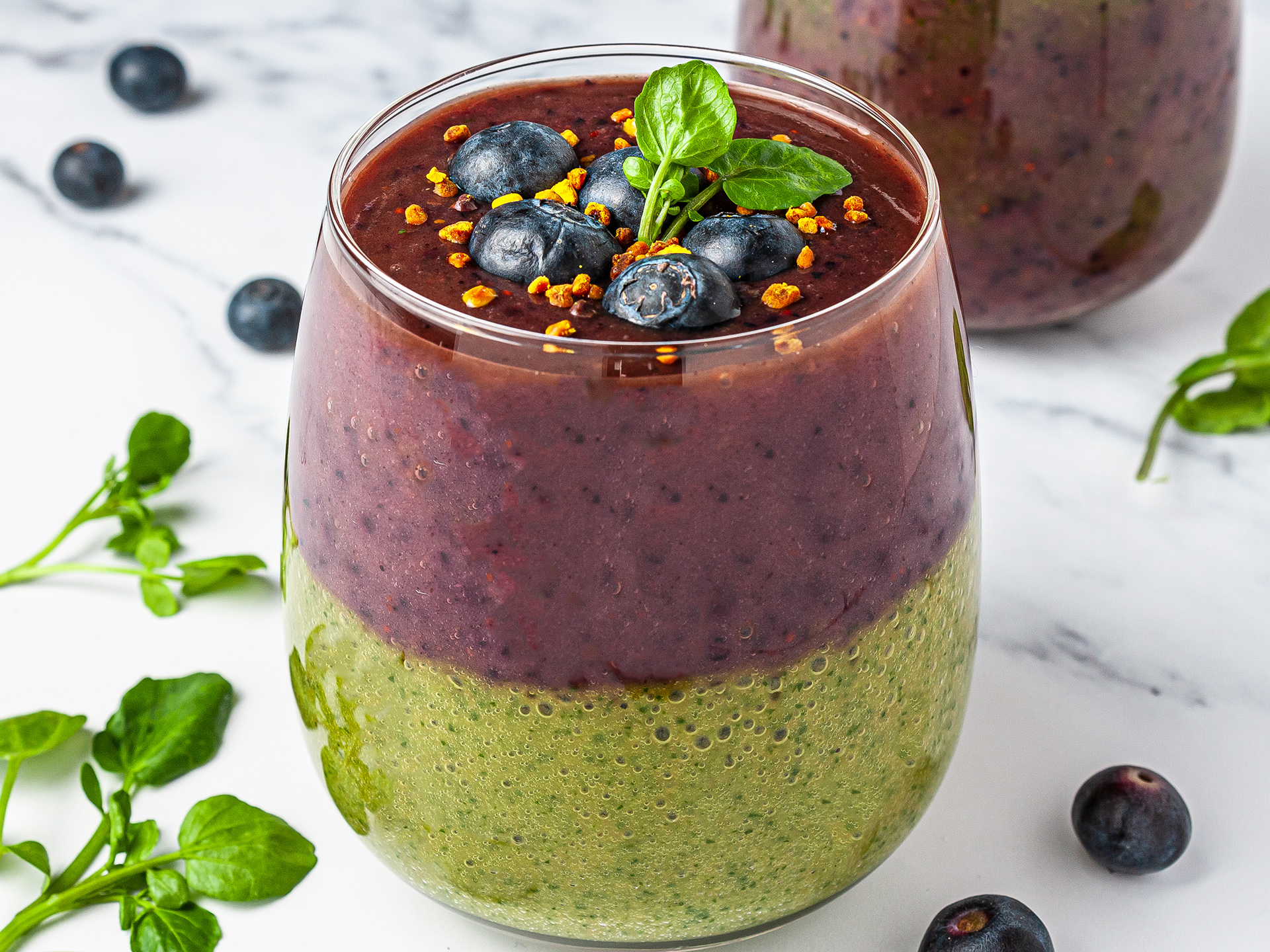This low-calorie watercress and blueberry smoothie bursts with flavour and goodness, and it's perfect for breakfast or as a snack.
You can try this green smoothie recipe if you're following a weight loss plan or looking for a healthy drink for a detox day.
It provides two of your 5-a-day for fruit and vegetables, and it's loaded with fibres, to keep hunger at bay.
Blueberries and watercress contain potent antioxidants which help fight disease-promoting free radicals. While ginger also has anti-inflammatory and gut-healing properties, which make it a great ally to any detox plan.
Without dairy products like milk or yoghurt, we made this green smoothie with just coconut water. Coconut water is low in calories and provides valuable electrolytes, which promote rehydration after a workout.
If you think that green smoothies taste like grass, try this easy recipe, and you'll discover a brand new world of health-boosting drinks!
For more healthy detox smoothies, check out our beet and kale smoothie, raspberry kale smoothie for weight loss, high-fibre smoothie, detox parsley juice, or cherry smoothie with chocolate!
How many calories are in this blueberry smoothie?
This watercress blueberry smoothie has only 180 calories per serving, making a great breakfast or snack recipe for any weight loss plan. Blueberries and watercress are low-calorie ingredients yet high in nutrients and antioxidants.
Because we used coconut water instead of milk, this smoothie is also low in fats, with less than 2% of your recommended daily intake (RDI). It's also high in fibres, with 6.8g per serving, covering almost 30% of your RDI.
If you are following a calorie-restricted diet, we have an easy-to-use SmartSearch tool to filter our best recipes according to calories and nutrients. Be sure to check it out!
How long will this green smoothie last in the fridge?
You can store this green smoothie for 24 hours in the fridge, but it can keep up to 48 hours.
When storing smoothies, like for other cut or processed fruits and vegetables, it's essential to keep them refrigerated in tight seal containers. Heat and air are key factors responsible for food browning, spoiling, and loss of nutrients.
The oxygen in the air reacts with the plant chemicals, known as phenolic compounds, which have become exposed after cutting the fruit or vegetable. This process, called oxidation, causes the fruit to become brown and to lose essential nutrients, including vitamin C, vitamin A and E [1].
Therefore, storing this smoothie in an airtight bottle filled almost to the top will slow down the oxidation process. Also, by keeping it in the fridge, the low temperature will delay the depletion of vitamins.
As an extra tip to keep the smoothies for longer, you can try to use fruit and vegetables high in antioxidants, like berries and kale, or to add a splash lemon juice.
How to make a blueberry smoothie without milk or yoghurt?
Making a blueberry smoothie without milk or yoghurt is incredibly simple, as you can replace them with plant-based alternatives. For example:
Almond milk
Oat milk
Coconut milk
Soy yoghurt
Coconut yoghurt
Also, as milk and yoghurt are used to add thickness and creaminess to the smoothie, you can swap them with the following ingredients:
Bananas
Soaked flaxseeds
Soaked chia seeds
Avocado
Nut butter, like peanut butter or almond butter
As here at Foodaciously, we love making smoothies, we have created this simple guide on how to make a balanced smoothie. You can find how to make your next smoothie tasty and super nutritious. Be sure to check it out!
Why is blueberry smoothie good for you?
This blueberry smoothie with watercress is incredibly healthy as it makes a low-calorie drink that is high in fibres, low in fats, and bursting with precious antioxidants.
Each serving provides:
Only 180 calories, perfect for weight loss.
30% of you recommended daily intake of fibres, to fill you up for longer.
Two of your 5-a-day for fruit and vegetables, helping you reach a more balanced healthy diet.
100% of vitamin K from the watercress, which supports normal blood clotting and healthy bones [2].
50% of vitamin C from watercress and blueberries, to boost your immune system.
Valuable electrolytes from coconut water, to help you rehydrate.
Blueberries, watercress, and ginger are not only low in calories but also extremely high in antioxidants. They help you keep blood sugar levels under control and fight cell damaging-free radicals, promoting better health and well being.
If you're looking for a detox smoothie to include in your diet, this watercress green smoothie is a must-try.
We suggest you try 12 to 16 hours fasting window overnight and then break the fast in the morning with this smoothie. This way, you will give time to your organs to rest, push your liver to get rid of harmful toxins, and finally cleanse and re-energise your body with healthy nutrients [3].
Although we added matcha as an optional ingredient, we strongly recommend you add it to this watercress smoothie for a boost of energy and antioxidants. Matcha is a true superfood, great in so many ways. Check out this blog post here to discover more!
Can green smoothies replace vegetables?
A balanced smoothie can certainly help you reach the recommended intake of 5 servings of fruit and vegetables, promoting a healthier lifestyle. It might also be useful for those on a detox diet or with digestive problems.
However, smoothies shouldn't replace all the other sources of fruit and vegetables in your daily diet. National guidelines and health professionals recommend that these drinks should account for 1 to 2 servings of fruit and vegetables a day.
The reason being, processed fruits and vegetables are more easily digested than their whole counterparts. Therefore, your digestive system wouldn't have to work much to get to those nutrients, making you feel empty and hungry soon after.
Also, upon blending, the sugar molecules are released from the cells of fruits and vegetables, and they become free sugars. These sugars raise blood glucose levels more quickly than when they are found in the whole fruit[4]. They will make your blood sugars spike, eventually leading to a crush of energy, and even overeating and weight gain.
Moreover, just drinking smoothies won't make up for a balanced and healthy diet. You still have to consume meals rich in whole grains, healthy fats, and lean proteins.
To sum up, if smoothies help you include more fruit and vegetables in your daily diet, then by any mean keep enjoying them. You'll get vitamins, minerals, and antioxidants. However, try to limit them to 1 to 2 servings a day, and balance your diet with other sources of fruit and vegetables.
Ingredients
| Watercress | 60 g |
| Fresh Basil Leaves | 1 tsp |
| Bananas | 2 |
| Ginger Root | 4 g |
| Coconut Water | 250 mL |
| Matcha Powder (optional) | 1/2 tsp |
| Blueberries | 160 g |
| Dates | 4 |
Step 1
Rinse and drain the watercress, and then remove the stems to have a creamier smoothie that is also easier to digest.
In a food processor, add the watercress, fresh basil leaves, 1 banana, ginger root, 125 mL of coconut water.
For a boost of energy and antioxidants, add the matcha powder. It will make this green smoothie even greener!
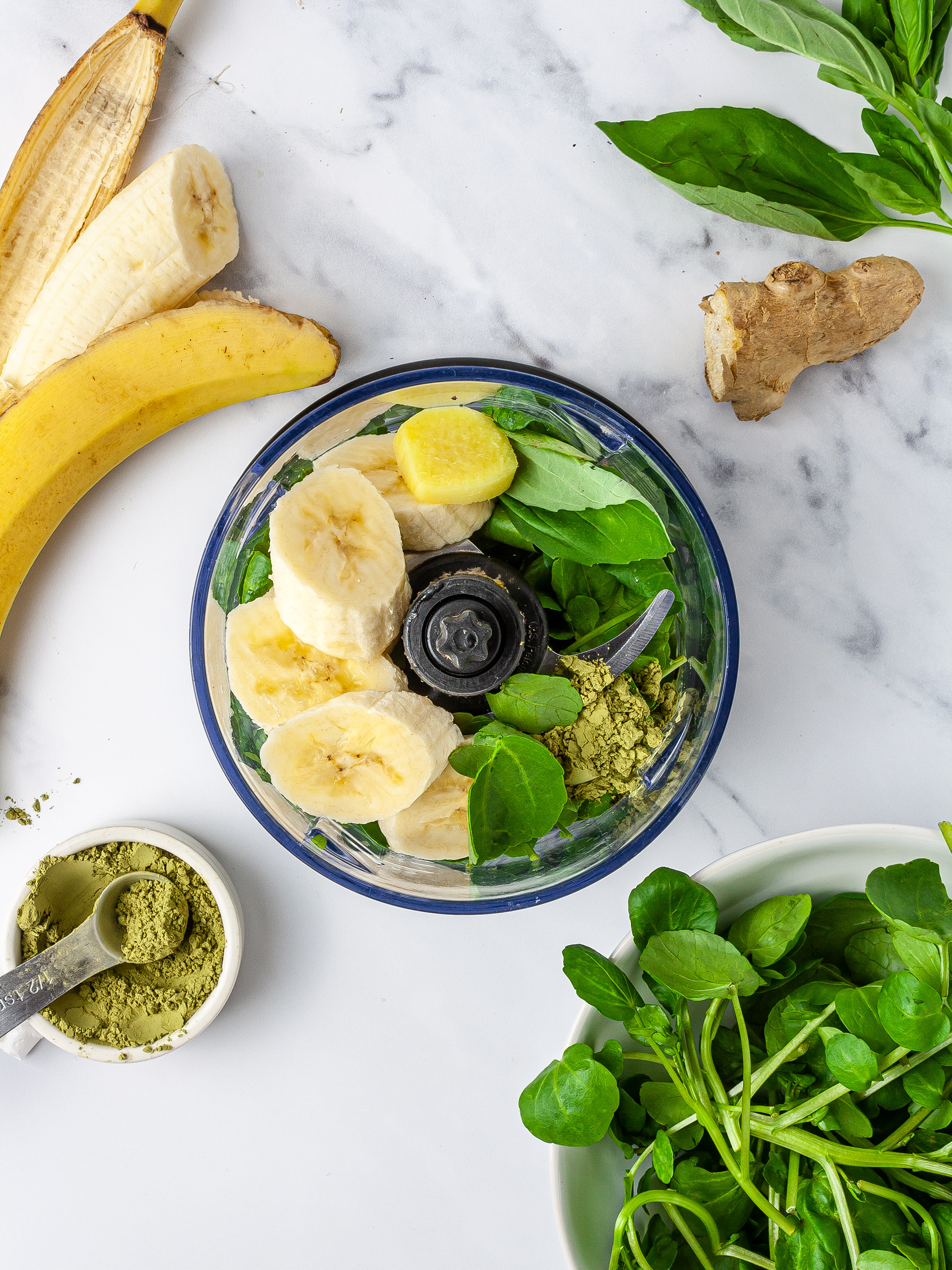
Step 2
Blitz the ingredients until you have a creamy green smoothie.
If you enjoy drinking from a straw, know that the bananas make this drink quite dense. We found you can still use a straw though. However, if you prefer a runnier smoothie, add a splash of coconut water and pulse again.
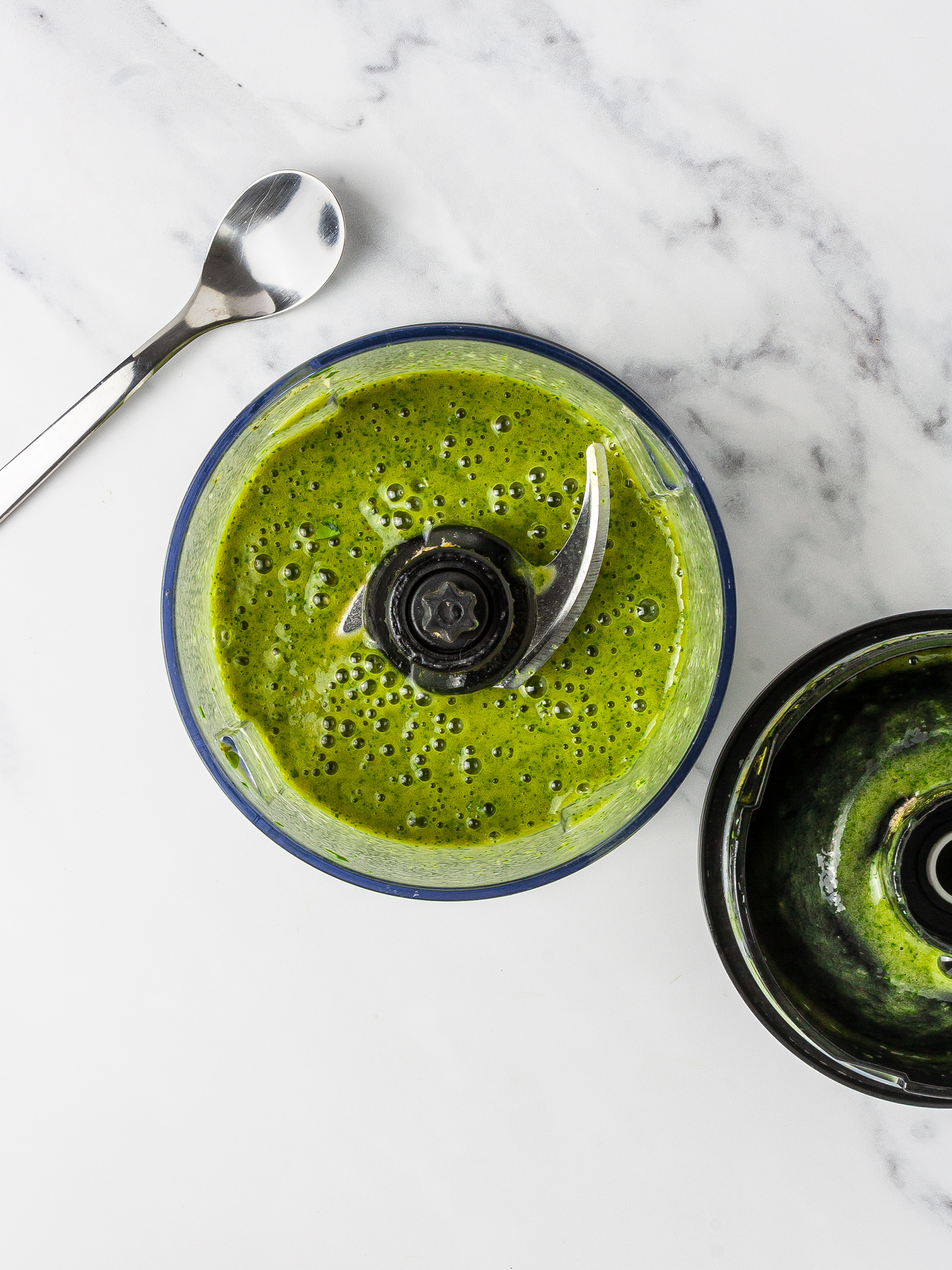
Step 3
Set the green smoothie aside, and add in the food processor blueberries, dates, 1 banana, and the remaining 125 mL of coconut water.
If the dates are a bit chewy, you can pre-soak them and 10 minutes and then add them to the food processor bowl. This way, they will blend more easily into a paste.
Blitz the ingredients until they turn into a creamy smoothie.
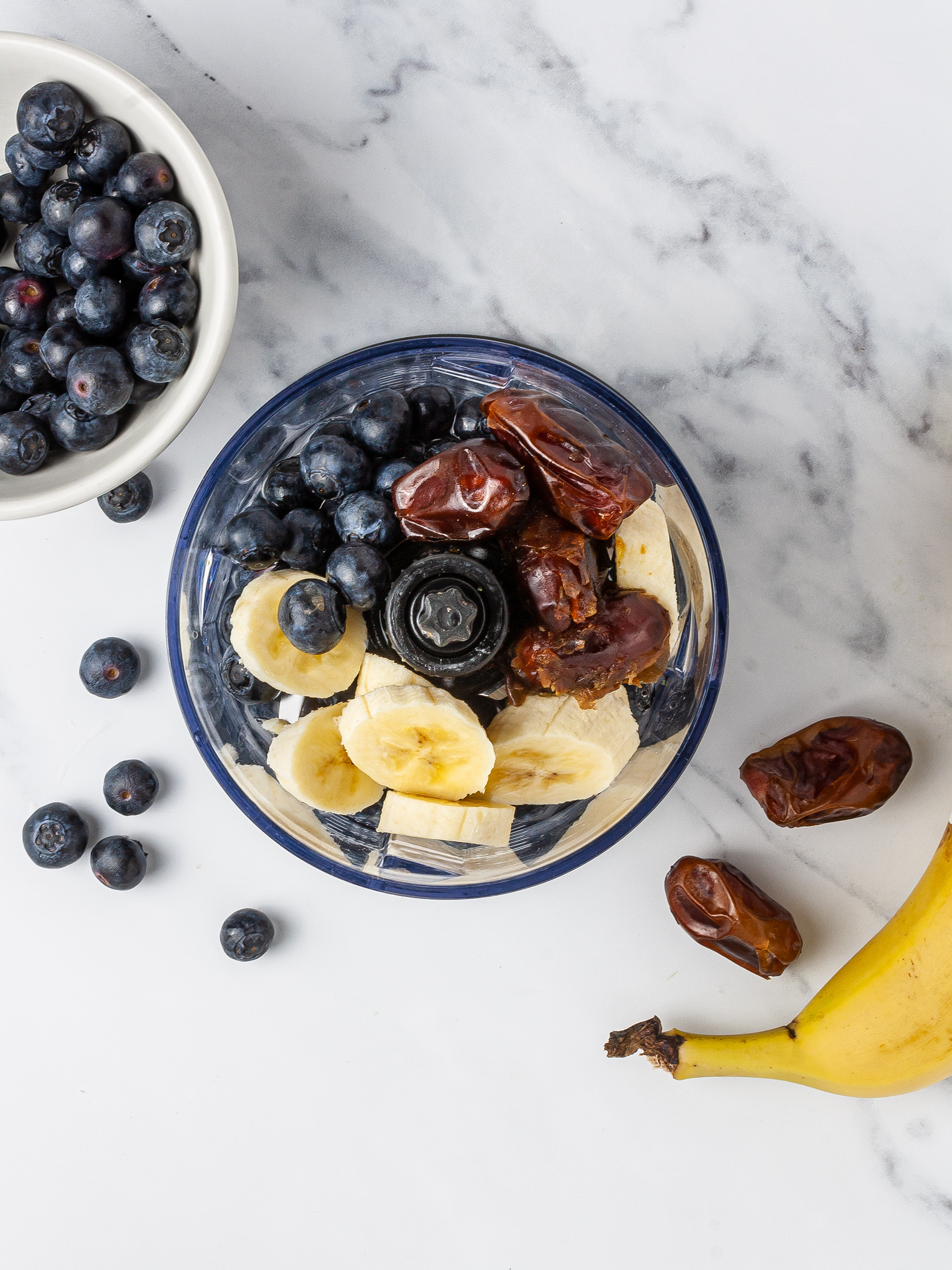
Step 4
Now, you are ready to pour this delicious smoothie into serving glasses.
For a beautiful presentation, pour the green smoothie first filling the glass halfway. Then, pour the blueberry smoothie to fill the glass. You can top it with blueberries, a leaf of watercress, and bee pollen.
In an alternative, you can mix the watercress smoothie with the blueberry smoothie in the glass for a swirl of colours.
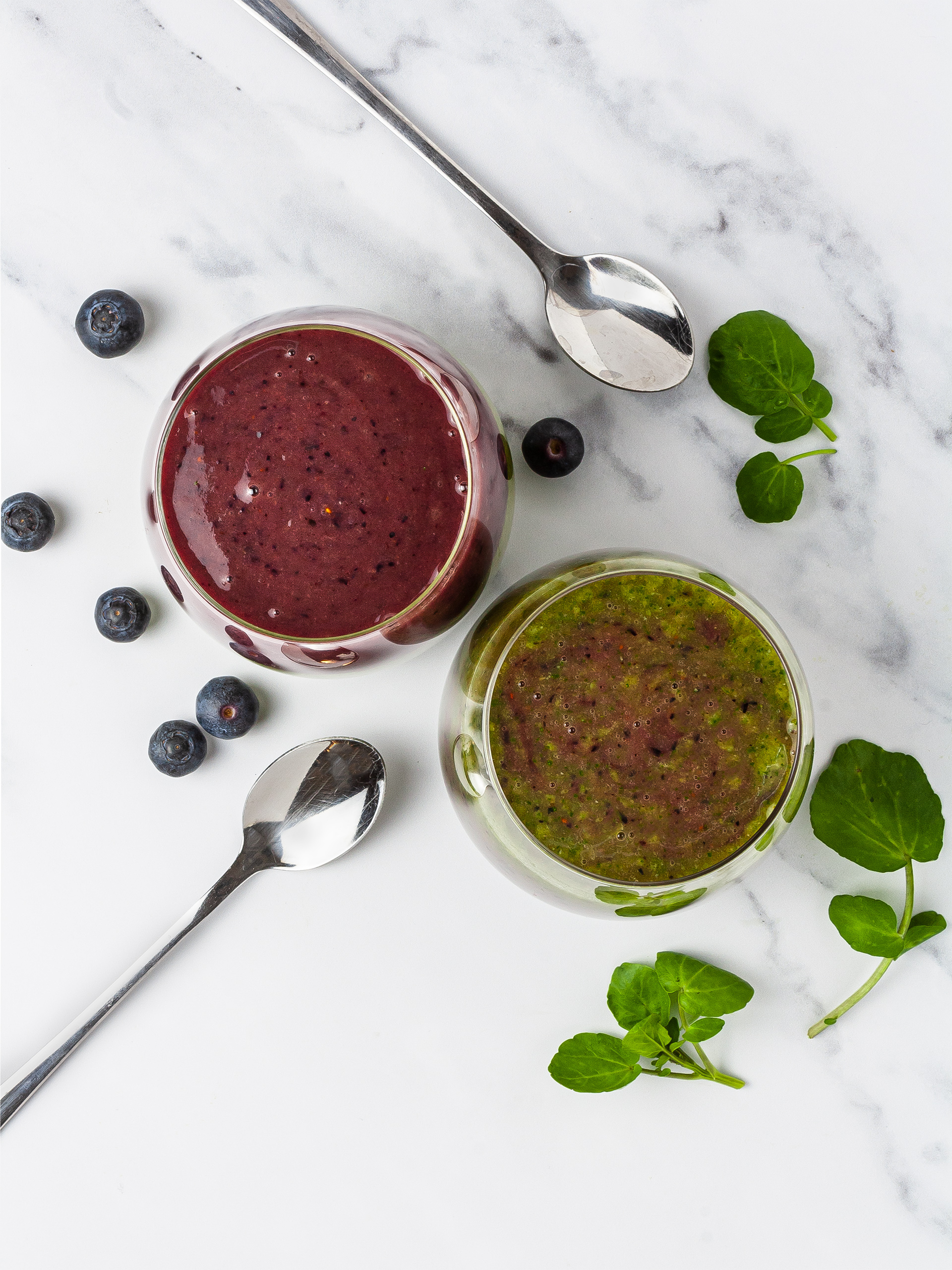
Tips
You can swap coconut water with coconut milk or coconut yoghurt for a creamier and more filling smoothie.
